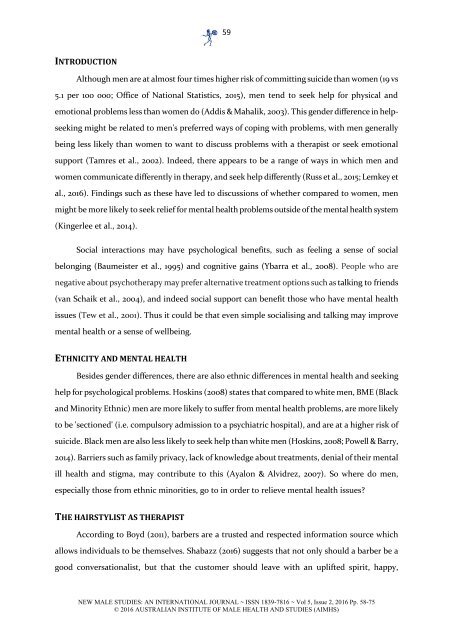IS HEALTH?
article-5
article-5
Create successful ePaper yourself
Turn your PDF publications into a flip-book with our unique Google optimized e-Paper software.
59<br />
INTRODUCTION<br />
Although men are at almost four times higher risk of committing suicide than women (19 vs<br />
5.1 per 100 000; Office of National Statistics, 2015), men tend to seek help for physical and<br />
emotional problems less than women do (Addis & Mahalik, 2003). This gender difference in helpseeking<br />
might be related to men's preferred ways of coping with problems, with men generally<br />
being less likely than women to want to discuss problems with a therapist or seek emotional<br />
support (Tamres et al., 2002). Indeed, there appears to be a range of ways in which men and<br />
women communicate differently in therapy, and seek help differently (Russ et al., 2015; Lemkey et<br />
al., 2016). Findings such as these have led to discussions of whether compared to women, men<br />
might be more likely to seek relief for mental health problems outside of the mental health system<br />
(Kingerlee et al., 2014).<br />
Social interactions may have psychological benefits, such as feeling a sense of social<br />
belonging (Baumeister et al., 1995) and cognitive gains (Ybarra et al., 2008). People who are<br />
negative about psychotherapy may prefer alternative treatment options such as talking to friends<br />
(van Schaik et al., 2004), and indeed social support can benefit those who have mental health<br />
issues (Tew et al., 2001). Thus it could be that even simple socialising and talking may improve<br />
mental health or a sense of wellbeing.<br />
ETHNICITY AND MENTAL <strong>HEALTH</strong><br />
Besides gender differences, there are also ethnic differences in mental health and seeking<br />
help for psychological problems. Hoskins (2008) states that compared to white men, BME (Black<br />
and Minority Ethnic) men are more likely to suffer from mental health problems, are more likely<br />
to be 'sectioned' (i.e. compulsory admission to a psychiatric hospital), and are at a higher risk of<br />
suicide. Black men are also less likely to seek help than white men (Hoskins, 2008; Powell & Barry,<br />
2014). Barriers such as family privacy, lack of knowledge about treatments, denial of their mental<br />
ill health and stigma, may contribute to this (Ayalon & Alvidrez, 2007). So where do men,<br />
especially those from ethnic minorities, go to in order to relieve mental health issues?<br />
THE HAIRSTYL<strong>IS</strong>T AS THERAP<strong>IS</strong>T<br />
According to Boyd (2011), barbers are a trusted and respected information source which<br />
allows individuals to be themselves. Shabazz (2016) suggests that not only should a barber be a<br />
good conversationalist, but that the customer should leave with an uplifted spirit, happy,<br />
NEW MALE STUDIES: AN INTERNATIONAL JOURNAL ~ <strong>IS</strong>SN 1839-7816 ~ Vol 5, Issue 2, 2016 Pp. 58-75<br />
© 2016 AUSTRALIAN INSTITUTE OF MALE <strong>HEALTH</strong> AND STUDIES (AIMHS)


